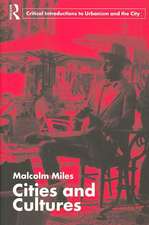Eco-Aesthetics: Art, Literature and Architecture in a Period of Climate Change: Radical Aesthetics-Radical Art
Autor Malcolm Milesen Limba Engleză Paperback – 7 mai 2014
| Toate formatele și edițiile | Preț | Express |
|---|---|---|
| Paperback (1) | 178.22 lei 6-8 săpt. | |
| Bloomsbury Publishing – 7 mai 2014 | 178.22 lei 6-8 săpt. | |
| Hardback (1) | 567.58 lei 6-8 săpt. | |
| Bloomsbury Publishing – 7 mai 2014 | 567.58 lei 6-8 săpt. |
Preț: 178.22 lei
Preț vechi: 207.24 lei
-14% Nou
Puncte Express: 267
Preț estimativ în valută:
34.10€ • 35.61$ • 28.22£
34.10€ • 35.61$ • 28.22£
Carte tipărită la comandă
Livrare economică 04-18 aprilie
Preluare comenzi: 021 569.72.76
Specificații
ISBN-13: 9781472529404
ISBN-10: 1472529405
Pagini: 256
Ilustrații: 36 illus
Dimensiuni: 138 x 216 x 15 mm
Greutate: 0.32 kg
Editura: Bloomsbury Publishing
Colecția Bloomsbury Academic
Seria Radical Aesthetics-Radical Art
Locul publicării:London, United Kingdom
ISBN-10: 1472529405
Pagini: 256
Ilustrații: 36 illus
Dimensiuni: 138 x 216 x 15 mm
Greutate: 0.32 kg
Editura: Bloomsbury Publishing
Colecția Bloomsbury Academic
Seria Radical Aesthetics-Radical Art
Locul publicării:London, United Kingdom
Caracteristici
Malcolm Miles is an internationally renowned cultural theorist specialising in art and culture
Notă biografică
Malcolm Miles is Professor of Cultural Theory in the School of Architecture, Design & Environment at the University of Plymouth, UK.
Cuprins
PrefaceAcknowledgementsList of illustrationsIntroduction1. Climate Change and Culture2. Ecologies3. Aesthetics 4. Ruins and Catastrophes5. Regressions and Reclamations6. Representations 7. Interruptions8. Cultures and Climate Change BibliographyIndex
Recenzii
Torn between hope and despair about the disastrous consequences of climate change, the question runs burning through our cultural life: what role can art, literature and architecture still play? Reading Malcolm Miles' book we learn that there is no one-line answer on this question. Page by page however he teaches us that there is a beauty in critical thought and perspective on what is going to happen. Taking a wide range of positions and cases into examination, Miles convinces the reader that the ruins of climate change, at least, do not need to be the ruins of our civilization.
Malcolm Miles' Eco-Aesthetics is an erudite, elegant, informed and critical account of art in the age of seemingly inexorable climate change
In this impressive and wide-ranging book, Malcolm Miles sets out lucidly the case for a new approach to aesthetics that can form part of a 'long revolution' in our response to ecological issues. Balanced carefully between hope and despair, it serves both a cri-de-coeur and a celebration of the human creative spirit in the face of a global capitalist system which shows little interest in such values.
In this slim, elegantly written volume, Miles charts a radical new path for the field of environmental aesthetics . Miles is not naïve: he does not present art as something that can magically bring today's environmental state of emergency into sharper focus. Nonetheless, through rethinking and contextualizing ecologies, aesthetics, and cultures of climate change by reference to art, Miles brings readers face-to-face with both the despair of Earth's future and the hope that one can indeed take some positive action against the ravages of climate change. The hope illuminated so intelligently in this book is an offering of beauty, which, as "radically other to routine," can indeed re-inflect today's culture. Summing Up: Highly recommended. Lower-division undergraduates and above; general readers.
Malcolm Miles' Eco-Aesthetics is an erudite, elegant, informed and critical account of art in the age of seemingly inexorable climate change
In this impressive and wide-ranging book, Malcolm Miles sets out lucidly the case for a new approach to aesthetics that can form part of a 'long revolution' in our response to ecological issues. Balanced carefully between hope and despair, it serves both a cri-de-coeur and a celebration of the human creative spirit in the face of a global capitalist system which shows little interest in such values.
In this slim, elegantly written volume, Miles charts a radical new path for the field of environmental aesthetics . Miles is not naïve: he does not present art as something that can magically bring today's environmental state of emergency into sharper focus. Nonetheless, through rethinking and contextualizing ecologies, aesthetics, and cultures of climate change by reference to art, Miles brings readers face-to-face with both the despair of Earth's future and the hope that one can indeed take some positive action against the ravages of climate change. The hope illuminated so intelligently in this book is an offering of beauty, which, as "radically other to routine," can indeed re-inflect today's culture. Summing Up: Highly recommended. Lower-division undergraduates and above; general readers.
































